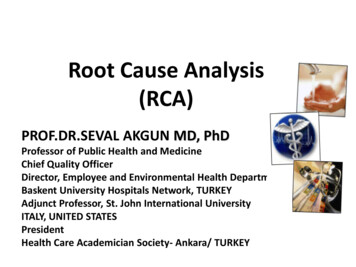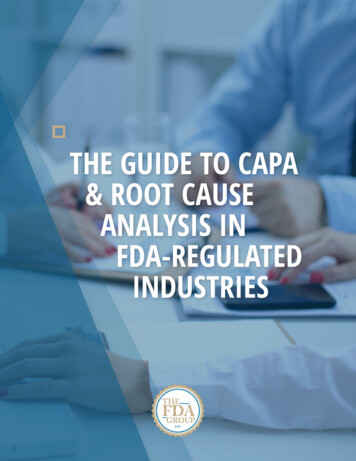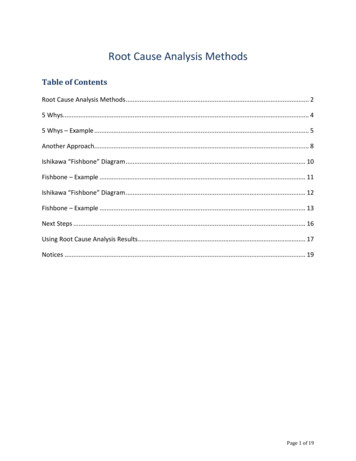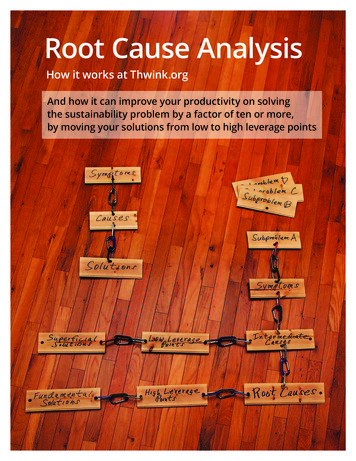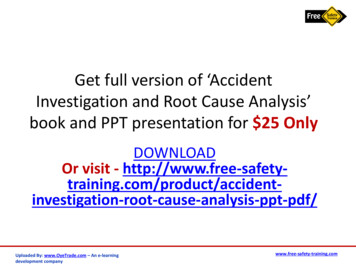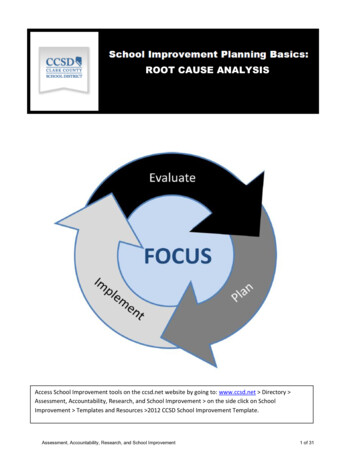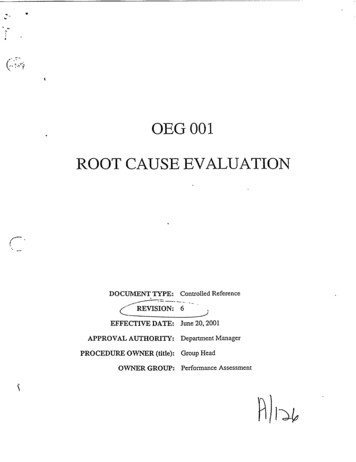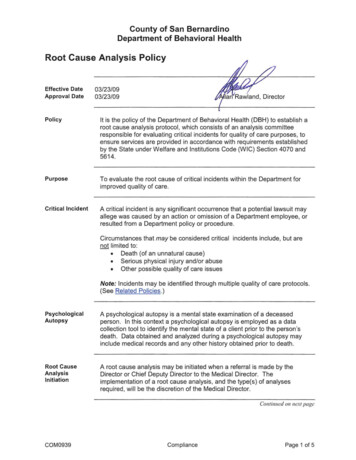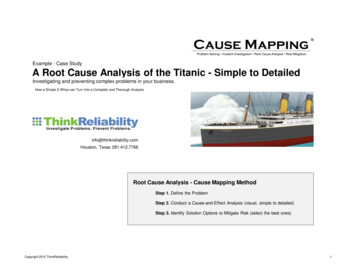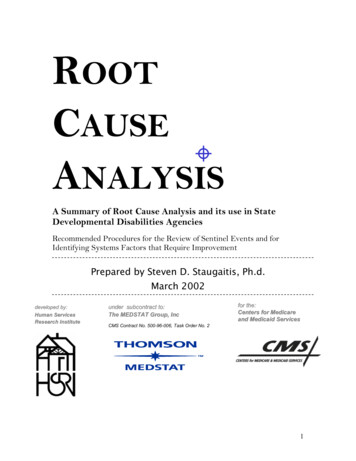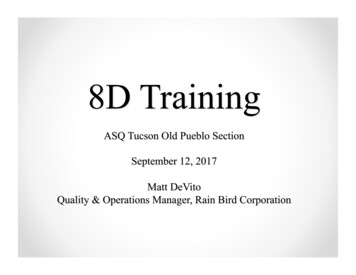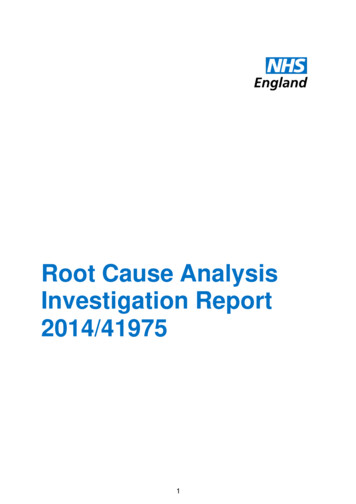
Transcription
Root Cause AnalysisInvestigation Report2014/419751
PUBLISHED MAY 2016Root Cause Analysis Investigation ReportIncident Investigation Title:Unexpected Child DeathIncident Date:14/12/2014Incident Number:STEIS REF : 2014/ 41975(Steis No or unique identifier)Final Report: 10th May 2016Prepared by NHS England South (South West)Panel Members for the Final Report:Director of Commissioning Operations, NHS England South (South West) (Chair)Deputy Medical Director, NHS England South (South West)Quality and Safety Manager, NHS England South (South West)Clinical Governance Lead, NHS Kernow CCGMedical Director, NHS Kernow ductionIncident DescriptionTerms of ReferenceScopeList of InformationList of contributorsCommunication, monitoring and evaluationInvolvement and support of familyRoot Cause AnalysisBackground and SummaryFindings and AnalysisProblem identification and Contributory FactorsConclusionsRecommendationsAction PlanPage334455667711151821222.
PUBLISHED MAY 20161. Introduction.This report is the outcome of a multi-organisational investigation into theunexpected death of William Mead (William) on Sunday 14th December 2014. Theapproach taken was to identify any underlying causes or influencing contributoryfactors leading up to William’s death so that lessons may be learned andimprovements made. This greater understanding is intended to result in the risk ofsimilar incidents occurring in the future being reduced.2. Incident Description.2.1 William was born on 27th November 2013 and tragically died on the 14thDecember 2014. The cause of death was established at Post Mortem as:a Septicaemia (Group A Streptococcus)b Empyema of left pleural cavityc Bronchopneumonia with Abscess of left upper lung lobe2.2 William’s death was initially reported on 24th December 2014 through the STEIS(Strategic Executive Information System) by Cornwall Partnership FoundationNHS Trust, the local provider of children’s services. Subsequently NHSEngland - South (South West) (SSW), as the commissioners of primary care,asked the family’s general practice (the practice), to do a Significant Event Audit(SEA). This was done and it was shared with the NHS England SSW Quality &Safety team. At that time the cause of death was understood to be naturalcauses and the serious incident investigation process was therefore stooddown.2.3 Subsequently the coroner’s inquest on 10th June 2015 identified missedopportunities for an earlier diagnosis and escalation which probably could haveprevented the death of William. The investigation process was therefore reinstated jointly between NHS England SSW and NHS Kernow ClinicalCommissioning Group (CCG).2.4 NHS England has acted as lead investigator in partnership with NHS KernowCCG, the latter being commissioner for the out of hours [OOH] service andNHS 111 services. South Western Ambulance Service NHS Trust [SWASFT] isthe provider of the 111 services and has cooperated fully with the Root CauseAnalysis. At the time Serco was the provider of the OOH service. Sercoprovision of Out of Hours has now ceased but its records were obtained toinform the process.3.
PUBLISHED MAY 20163. Terms of Reference.3.1 Purpose To explore all elements of the NHS care and treatment of William leading up tohis death and, in particular, care and treatment provided by the GP practice, theSWASFT 111 service and the Serco OOH service. To seek responses to the questions provided by William’s mother Melissa Mead(Mum) regarding his care and treatment, and the experiences of the family. To reflect on and identify any issues or missed opportunities. To understand any contributory factors and identify any root causes. To identify learning from this incident to share and inform associated localand national sepsis work streams.3.2 Objectives To identify and review relevant information in order to identify improvementsand learning rather than to apportion blame. To work collaboratively as commissioners of the service providers involved. To establish how recurrence of incidents of this nature might be prevented orthe risk of recurrence reduced. To formulate recommendations and an action plan. To provide a report as a record and summary of the investigation process. To share learning from the investigation. To operate an open and transparent investigation process.4. Scope.4.1The scope of the investigation is defined as the time period covered forthe purposes of fact-finding and analysis.4.2For the sake of completeness, the timeline and information gathered beganfrom the first presentation of William at his GP practice with a persistentcough in September 2014. This is to take account of the concerns of thefamily that the cough and earlier illnesses were a contributory factor in thefinal illness.4.3Therefore the timeline included all details from the William’s GP records from30th September 2014 to 14th December 2014.4.
PUBLISHED MAY 20165. List of Information Gathered to Support the Investigation Process. Timeline/chronology of contacts with services. Initial management report by Cornwall Partnership NHS Foundation Trust. SEA and full report from the practice. Serious Incident Investigation & RCA, SWASFT. CD recordings of coroner’s inquest and statements. Transcript of NHS 111 telephone call. Transcript of telephone conversation with OOH GP. Information provided by the parents of William, including a set of questions aboutWilliam’s care and treatment given to Lindsey Scott during her meetings withMum. Witness statement of Mum as provided to the inquest. Meetings with the practice and SWASFT.6. Investigation Team and Contributors to this Report.6.1 RCA Team Deputy Medical Director, NHS England - South (South West) [SSW]. Director of Nursing and Quality, NHS England SSW. Quality and Safety Manager, NHS England SSW . Clinical Governance Lead, NHS Kernow.6.2 Contributors / people discussions were held with Assistant Director of Nursing, NHS England SSW. Professor Peter Fleming - Professor of Infant Health and Development Melissa Mead (Mum). Executive Director of Nursing and Governance SWASFT. Patient Safety Manager SWASFT.5.
PUBLISHED MAY 2016 Regional NHS 111 Clinical Governance Lead. GP practice7. Arrangements for Communication, Monitoring and Evaluation of Actions.7.1In the spirit of openness and transparency, and in line with thecommitment of the organisations involved to the Duty of Candour, thisreport has been shared with the parents of William at various stages of itsdevelopment and who have been able to contribute (see section 8).7.2Whilst RCA reports are not normally published, although they areobtainable via Freedom of Information requests, the parents of Williamhave agreed with NHS England SSW that this one will be a collaborativerelease in order to raise the profile of the lessons learnt about theprevention of childhood deaths as a result of pneumonia, empyema andsepsis.7.3Equally the report has been shared in its development with theorganisations involved and the named practitioners.7.4NHS England SSW will oversee the implementation of the action planand the parents of William will be invited to be ‘critical friends’ in thisprocess, in line with our commitment to public accountability.7.5NHS England SSW will ensure that the learning and the action planboth informs and is aligned with the local SW action plans and nationalwork to prevent death of pneumonia, empyema and sepsis.8. Involvement and Support of Family.The parties involved in the RCA process and production of this report areCommitted to meeting the Openness & Transparency requirements of public bodies,and the Duty of Candour. In this case the team involved have, they believe, done thisin a totally open and new way. The parents of William have been involved at allstages in order that we could: Understand and include the vital information on events from the perspective ofthe parents. Have ongoing discussions with them to ensure that the conclusions andrecommendations were logical to them and understandable i.e. not usinglanguage which is not clear and understandable to non-medical / clinicalindividuals. Be involved in the process of learning and the action plan which will result fromthis RCA.6.
PUBLISHED MAY 2016The RCA panel / team are indebted to William’s parents for their persistence inensuring that all of the facts were understood and that lessons would be learnt, andfor their understanding approach in the context of devastating circumstances forthem. The parents of William do want an apology from the parties and organisationsconcerned. SWASFT has already issued a formal apology to them. NHS England willgive an overall apology to them on behalf of all the NHS organisations involved. TheOOH doctor formally recorded his apology at the inquest. One of the GPs from thepractice has communicated in writing an apology to the parents and a private meetingbetween this GP and Mum has also taken place.9. Description of Root Cause Analysis (RCA).RCA is a methodology applied to support and add rigour to serious incidentinvestigations by applying a systematic process whereby the factors thatcontributed to an incident are identified. It is the preferred investigation techniquefor investigation of safety incidents. Fundamentally, it not only looks at theindividuals involved in William’s death but also looks beyond the individualsconcerned and seeks to understand the underlying causes and environmentalcontext in which an incident happened.10. Background and Summary.This section contains a descriptive chronology of the events leading up to the death ofWilliam. It is a broad level summary of William’s contact with health care professionalsand service providers in the defined period. It is a summary and is supported by thedocuments and by interviews with individuals involved.September 2014On or around the week commencing the 8th September William went to nursery for thefirst time and attended on Mondays, Thursdays and Fridays. Mum notes that hedeveloped a cold and cough once he started nursery and that this continued untilWilliam died. Mum notes that on occasions this would cause him to be sick and thiswas a daily occurrence from November.13th September 2014 – Attendance at Royal Cornwall Hospitals NHS Trust A&EThe GP practice received a discharge notification that William had been taken to A&Eby his parents, suffering from possible gastroenteritis. The records note that he hadvomited 4 times that day. He responded well to fluids / rehydration and wasdischarged home with medical advice being given to his parents.30th September 2014 – GP appointment, The PracticeWilliam had been unwell with a fever for a day or two and was brought to surgery andseen by Dr Z. On examination he was found to have erythematous and exudativetonsils with a temperature of 38.5. Capillary refill was 2 and there no signs ofrecession or systemic distress.7.
PUBLISHED MAY 2016William was able to drink fluids well. His chest, ears and abdomen were normal. Hewas diagnosed with tonsillitis and treated with Calpol and Amoxicillin.1st October – GP appointment, The PracticeWilliam had developed a rash and was seen at the surgery by Dr W. William wasnoted to have a speckled erythematous rash which was blanching over the loweraspect of his legs. At that time he was noted to be alert, well and engaging with acapillary refill of 2 seconds and a noted as a well-looking child. The notes questionwhether this might be a streptococcal-related rash, but as he was already onantibiotics and making a recovery he was allowed home with his parents givenongoing advice regarding nursery.13th October 2014 – GP appointment, The PracticeWilliam’s rash had started to go down but his cough had developed into a chestycough. Mum was concerned as the cough was persistent. Mum recalls that Williamseemed more tired than usual and less playful, and had become unwell at nurserywhere he attended 3 days a week.William was seen by Dr Z who noted that his throat was much better. Dr Z recordedWilliam as systematically well although noted to have had a cough for the past coupleof weeks. He was noted to have been drinking and eating normally. On examinationhis throat was fine, his chest clear and there were no signs of respiratory distress, hiscapillary refill was 2 seconds and he was afebrile.11th November 2014 – Telephone call to the PracticeOn the 11 of November Mum rang the practice to say that William had been coughingand vomiting after eating. She reported that this has been going on for approximately4 weeks. He was invited in for a review appointment.12th November 2014 – GP appointment, The PracticeWilliam was reviewed by Dr X. Dr X recorded that she considered William to be welland engaging. He was afebrile with a temperature of 36 degrees, capillary refill of 2seconds, no respiratory distress, normal heart sounds and a clear chest with nowheeze or crepitations evident. Dr X noted him as ‘snotty’ and coryzal, noting aworking diagnosis of upper respiratory tract infection with a possible potentialunderlying bronchospasm secondary to a strong family history of asthma. Dr Xprescribed a salbutamol inhaler with an Aerochamber Plus with Infant Mask, 2 puffsas required 4 times a day.Dr X confirmed that it wasn’t a ‘diarrhoea and vomitingpicture’ but that the vomiting was due to the cough. No follow-up taken following theprescription of the inhaler.21st November 2014 – GP appointment, The PracticeWilliam was sent home from nursery due to his cough and the vomiting. William wasseen by Dr Z who notes in the records that William had an upper respiratory tractinfection, NOS, cough symptoms of the last few days on and off, and coughing causingvomiting. Dr Z considered William to be interactive and smiling, with a clear chest andnormal observations.8.
PUBLISHED MAY 2016Mum told the doctor that the inhaler was not having any effect, although this is notnoted in William’s record. Mum was concerned that the cough and vomiting wasincreasing to sometimes 6-7 times daily. Mum recalls that Dr Z said this was normal.The nursery were concerned that William was infectious and so Dr Z wrote a letter forWilliam’s parents to take to nursery to say that the vomiting was due to the cough, sohe could continue to attend nursery.8th December 2014 – Practice Nurse appointment, The PracticeWilliam received his childhood booster vaccinations HIB and MEN C.9th December 2014 – Notes from MumMum recalls that William was not himself, tired and unwell. She had been told bythe Practice Nurse on the previous day that the vaccine could often make childrenfeel ‘off colour’, so she attributed it to that.11th December 2014 – Notes from MumWilliam went as usual to nursery on this day. Mum provided the nursery staff withliquid paracetamol and explained that he wasn’t himself and had just had vaccines.When William was collected, the staff confirmed that he had not himself. William wastaken home where he ate his dinner; he woke once in the night, was soothed andsettled down again.12th December Mum’s notes and Nursery notesWilliam refused his breakfast, which Mum recalls as unusual as he usually enjoyedhis food. He was taken to nursery as normal and arrived between 8 and 8.30am.William was noted by his key worker to be OK in the morning. He had been teethingfor the last two weeks so was a bit under the weather but nothing unusual. Williamwas noted during that day to be playing, and seemed content in the morning and notoverly clingy. However, his key worker did note that he did not eat his morningsnack, which was unusual for him.As the day progressed, William was noted to become more agitated and at around11.30am William was given the liquid paracetamol provided by Mum. This seemed tohelp, although he did not eat his lunch and was noted to be tired, so the staff putWilliam down for a sleep. He was noted to fall to sleep quickly. However, when hewoke he was upset. The staff took his temperature and recorded it as 37.8. Staffwere concerned as he had had liquid paracetamol in the previous few hours and yetthe temperature was still high. They rang William’s father to come and collect him.12th December GP appointment, The PracticeAn emergency appointment for William was made at the GP practice and Williamwas taken by his father and seen by Dr Z around 4.40pm. Dr Z examined Williamand noted that he found William febrile and coryzal with flushed cheeks. Williamhad been given liquid paracetamol one hour before being brought to surgery. Dr Zconsidered William to be alert and engaging, although quieter than his usual self.9.
PUBLISHED MAY 2016Dr Z recalled that at the time William’s temperature was 40 degrees, although this wasnot formally recorded in the notes. Dr Z noted capillary refill 2 seconds and norashes. His ears were clear, throat fine and his chest was clear with no signs ofrespiratory distress or increased respiratory rate. Dr Z did not record the heart rate.Abdominal examination was unremarkable and he seemed systemically well. Dr Zgave safety-netting advice should William’s condition worsen, and supportive adviceregarding his fever, fluids and the need for further review if he were to worsen or showany change over subsequent days. Upon leaving the appointment, William’s fatherrecalls asking when William should be taken in, upon which Dr Z’s advice was that itwas ‘nothing grisly’.12th December Evening notes from MumOn the evening of Friday the 12th December, William was restless and ‘not feeding’.Mum recalls that he remained restless throughout the night and that his temperaturehad risen again. He was given liquid paracetamol and soothed until he rested.Saturday 13 December– Telephone call to NHS 111Mum recalls that William was vomiting a lot more and that the vomit was green andyellow in colour. William also seemed more tired than usual. At around 4pm Mumphoned NHS 111 for advice. The NHS pathways assessment was undertaken by a calladvisor and the end disposition was to receive a consultation with a health carepractitioner within 6 hours via the Cornwall Out of Hours provider. In addition the patientwas offered the opportunity to attend the local treatment centre.The pathway chosen was ‘Vomiting and/or Nausea’. The call lasted 14 minutes.The detail of the call and disposition was then passed to the out-of hoursprovider, Serco.Saturday 13 December - Serco Health OOH provider – telephone consultation withDr Y.At 6.52pm, Dr Y telephoned William’s parents. Dr Y confirmed with Mum that heunderstood that William had been unwell, vomiting, with severe pain, and had recentlyhad 1-year booster.Mum advised that William had been a bit off all week but teething as well. He had goneoff his food and had taken no food since the previous morning, although was takingsome fluids. Mum also provided an account of visit to family GP the previous day.Dr Y discussed William’s condition with Mum and asked if she would like to bring himto the Falmouth Clinic. By this time, William had gone to bed and he seemedpeaceful. Mum asked Dr Y for his professional opinion, which was that William shouldbe left to sleep.William’s parents went to bed at around 10.30 pm and observed that William wassleeping. There was constant video surveillance on William throughout the night.Dad recalls noting William moving about at around 5am.10.
PUBLISHED MAY 2016At around 8.30am the next day, Mum discovered William was not breathing andphoned 999. South Western Ambulance subsequently attended and William waspronounced dead at approximately 8.47 am.11. Findings and Analysis.11.1 Main PurposeThe main purpose of this investigation is to explore all the events leading up toWilliam’s death and to understand at what point in William’s illness might there havebeen an opportunity to recognise and treat the underlying condition that resulted in hisuntimely and tragic death. Through the course of this analysis, other factors (problems)may be identified that did not specifically impact on the outcome but that are noted asareas for improvement or learning. The details and background of this investigationhave been reviewed by a multi-agency panel representing the relevant healthcareorganisations. The panel has developed the discussion, analysis and findings thatform part of the final conclusions and will inform recommendations and an action plan.11.2 Persistent CoughThe persistent cough that William had in the weeks leading up to his death isparticularly common in children from around 9 months to a year, and particularlyaround the time they begin to attend nursery.Despite the common nature of the symptoms, the records show that in NovemberWilliam was presenting with symptoms of persistent coughing and vomiting, withgreen phlegm being produced over the last 6-8 weeks. There were a number ofopportunities in this period to treat the infection and possibly to prevent thedevelopment of the pneumonia. This was discussed in detail at the inquest.The panel also concluded that there were opportunities for primary care to considerthe history and recurrent attendances of William to them as a trigger for referral forfurther investigation or treatment i.e. referral to a paediatrician, a CXR and / orprescription of further antibiotics.The general practitioners on the panel considered that those involved in the primarycare response did not fully consider the attendances of William and that had theydone so they might have identified that the pattern required further referral, asdescribed in the paragraph above. Specifically, the following attendances areconsidered as material in requiring primary care to take more- active interventions: 13th October attendance at the surgery12th November attendance at the surgery21st November attendance at the surgery.The prescription of inhalers on the 12th November was not in the panel’s opinionappropriate for a child of William’s age. Nevertheless, having been prescribed, itshould have resulted in a follow-up of progress etc; this did not happen.11.
PUBLISHED MAY 201611.3 Childhood VaccinationsMum asked if the vaccinations given to William on the 8th December could havecompromised William’s immune system.During giving his evidence at the inquest, Professor Fleming said that the evidencewas in fact the other way around, in that in the period immediately after the injectionthe immune system was stronger and other infections were slightly less likely toprogress. The reason that vaccines are not given to people who are unwell is becausethey can mask or confuse what is actually happening with them, not because there isan increased risk of an infection getting worse or being contracted. The vaccinesgiven are not ‘live’, so this is not an immunisation that in itself could cause a seriousillness.11.4 GP Appointment Friday 12 DecemberDuring the inquest, expert witness Professor Fleming advised that the type ofstreptococcus that was identified at post mortem was an invasive and rapidlyprogressing infection. It was most likely that William’s illness was developing a fewdays before his death. Therefore the episodes and sequence of events in the 24-48hours before William’s death were crucial.When Dr Z examined William on Friday 12th December, he did not consider William tobe critically ill and requiring a hospital referral. Dr Z was concerned about his hightemperature but did not identify any other signs which would trigger a hospital referral.He did not record the temperature and he did not take the heart rate.There are NICE guidelines (CG160) which advise GPs about feverish illness inchildren. These are designed to help the GP assess children with febrile illness, andthe presence or absence of symptoms and signs which can be used to predict the riskof serious illness using a traffic light system. In this case, the GP did not record thetemperature on the records, although he did take the temperature and both he and MrMead recall it being 40C. Dr Z did not take William’s heartrate when listening to thechest. The respiratory rate and capillary refill time were noted. The symptoms andsigns of specific illness are listed in the NICE guidelines; they include pneumonia.None of these signs were identified. It is likely that the heart rate would have beenelevated but this would, if it had been recorded and the case, have resulted in amberflag.The panel notes that recent NICE guidelines for sepsis have been issued forconsultation (due to be published July 2016). If these had been applied to this case andthe heart rate had met the appropriate threshold this would have resulted in a red, notamber flag.At the time of the consultation Dr Z did not therefore identify any symptoms or signswhich would directly indicate to him that William was in a high-risk group for seriousillness. What he identified were intermediate risk features.However, it is the conclusion of the panel that Dr Z should have referred Williamto hospital at that point, as the expert witness has pointed out that the pneumoniawould have been present at that time.12.
PUBLISHED MAY 2016The history was that William had had 3 significant attendances to primary carebetween 13th October and 21st November, in addition to the attendance on the 12thDecember and this was discussed at the inquest. The Panel discussed at when theseattendances should have warranted consideration of antibiotics, referral to apaediatrician or A&E and / or for a CXR. The Panel postulated that the use ofantibiotics at the earlier appointments may have prevented the pneumonia.Reference is made to safety-netting advice given to William’s father in the GP notes.There were no specific indicators given to the parents about what constituted‘worsening of symptoms’, and no written advice. Whilst this is common practice inprimary care, it is an area that the panel identified as requiring improvement. It isconsidered that parents require much more specific advice and information as towhat constitutes a deterioration and which triggers should lead them to seek furtherurgent medical advice and review.The panel also considered the fact that 12th December was a Friday evening and thatany safety-netting advice given prior to a weekend should be ‘enhanced’, in that thenormal weekday NHS services will not be accessible over a weekend.11.5 Call to NHS 111On Saturday 13th December, a call was made by mum to NHS 111. The callhandler ran through the NHS algorithm and did not identify a seriously-ill child. Areview of the telephone recording did not identify any serious failings in decisionsmade by the call handler, but there were opportunities to have explored William’scondition further. These missed opportunities do not in themselves constitute aserious failure, but in hindsight the following elements have been identified bySWASFT as learning points and missed opportunities:Breathing – the question asked was, ‘Is he fighting for every breath?’ The calleranswered ‘no’, but went on to state he had an inhaler and his breathing was‘slightly more labored but not fighting’. The caller further offered that the patient hadbeen coughing for 2-3 weeks. The Call Advisor did not sufficiently probe aroundthese points in order to gain further information. There is a potential missedopportunity to have gained information which might have resulted in a higher-acuityresponse through the identification of a complex case.Floppy / limp – the question was asked, ‘Is he limp or floppy?’. The caller stated thatthe patient was not floppy; however, he was limp and if you picked up his arm it justflopped down. This information was not probed further, nor was the caller given theopportunity to expand their answer. There is a potential missed opportunity here topick up on important information that could have resulted in a higher-acuity response.Abdominal pain – Pathways do not routinely use the abdominal pain pathwayfor children, as they are often unable to verbalise and describe their pain. Duringmodule zero (the first module for 111 services) the call advisors are trained to probearound the information given by the caller in order to select the correct pathway. Inthis case, the Call Advisor chose ‘vomiting’ as this was the primary symptomdescribed.In summing up the information given during module zero’ the Call Advisor states, ‘Heis unwell, he is vomiting, he is in severe pain, he has been like this for 1 ½ days’.13.
PUBLISHED MAY 2016Having listened to the call, at no point did the caller state the patient was in severepain; this was entered into the notes by the Call Advisor and was an interpretation ofthe information given. Within the vomiting pathway, abdominal pain is questioned andso the Call Advisor re-visited the question of abdominal pain. At this point there is nomention of severe pain and the caller does not give a positive answer to pain, so theCall Advisor selected ‘No’, which generated a 6- hour disposition. Had a ‘Not sure’been recorded, this would have directed the Call Advisor down the same route asanswering ‘No’. Given the way the questions were answered, a selection of ‘No’ or‘Not sure’ was appropriate. However, there is an expectation that the Call Advisorlooks to and considers the notes in module zero and also considers the answersaround crying.With a child this age, crying could indicate pain (although the source may not havebeen clear) and therefore a positive selection around the question may have beendeemed correct. A positive answer would have changed the disposition to a‘Primary Care within 2 hours’.Temperature – the caller described that William had had a temperature for the last 1½ days that had required liquid paracetamol in order to keep it down. It was noted thatat the point of the call the temperature was lower than expected. Pathways in 111services are not sensitive to a drop in temperature from high to low, which would be ared flag for a sepsis-type infection. In addition, the question in pathways around feverfor 3 days or more,
9. Description of Root Cause Analysis (RCA). RCA is a methodology applied to support and add rigour to serious incident investigations by applying a systematic process whereby the factors that contributed to an incident are identified. It is the preferred invest

